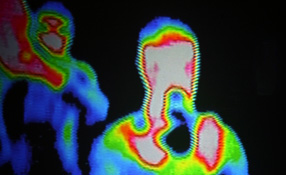 |
| Bridging the gaps in wired infrastructure with wireless broadband |
Benefits of IP-based video surveillance systems
In recent years, the video surveillance industry has taken giant steps towards infrastructure digitisation. This trend continues because digitisation enables them to replace the limited capacity and capabilities of analog transmission networks with the innumerable opportunities provided by IP networks. In particular, IP-based systems offer easy integration and interoperability with a multitude of other systems, enabling the development of a range of innovative telecom infrastructures.
IP-based surveillance systems offer much more than simple visual supervision; starting from a single centralised computer, they offer a range of benefits, which include:
- Real-time management and simultaneous surveillance of individuals and merchandise at multiple sites i.e. remote monitoring and security management
- Top quality recording of sound and images
- Control of traffic systems
The wireless alternative: A world of possibilities for communications networks
Such IP-based systems require an appropriate broadband network infrastructure. Today, there are a number of different options to obtain the necessary broadband access. This includes wireless broadband, which in many cases offers an excellent solution to bridge the digital divide in areas lacking a wired infrastructure, as well as an alternative to DSL.
Wireless broadband opens doors to 24/7 surveillance, which is inaccessible to most advanced wired infrastructures |
The availability of wireless broadband technologies (wireless local loop) allows for the deployment of broadband communications networks when wired technologies and infrastructures are either unavailable or cannot provide the required performance. Such networks can also be deployed as a complement to existing wired networks, extending coverage and/or capacity and offering new possibilities for modularity and mobility.
Growing reach of wireless network solutions
Since wireless broadband access became available, IP radio network technologies have been evolving to provide more bandwidth, reach, quality-of-service, and security - all critical parameters for video surveillance applications. It is now possible to quickly and cost-effectively deploy networks of CCTV cameras in a range of areas, such as public places, commercial centres and industrial zones, in order to ensure security as part of urban video surveillance applications. The wireless infrastructure also supports Intelligent Traffic Systems (ITS) including smart video surveillance, enabling cities to deploy a system that allows for bi-directional streamlining - upstream from the surveillance cameras and downstream from the control center - for enhanced traffic control. The advantage of such networks is that they can be deployed very quickly on affordable budgets, reducing operational costs and present the opportunity for utilising systems which cannot be deployed using wired infrastructure.
 View larger image |
| Various topologies are available for different wireless network scenarios |
For markets such as public transport or public security, wireless broadband opens doors to 24/7 surveillance, which is inaccessible to most advanced wired infrastructures. Wireless networks allow patrol vehicles to remotely share bidirectional videos, audio transmissions and other types of data with colleagues or management systems located in a single remote monitoring. Additionally, the same infrastructure can be used for Internet access, utilising the VLAN's feature.
Available topologies for wireless communications networks
Wireless communications networks use radio modems mounted on public or private buildings, water towers, poles or any other elevated structure in order to optimize transmissions. Area coverage uses point-to-point (PTP) and point-to-multipoint (PtMP) links, depending on the topology and the required architecture. Coverage can reach several kilometres (up to 30 km and more for a high capacity PTP link) and serve any type of public or private client.
- PTP topologies only permit communications between two points. This topology is used either for connecting a single remote surveillance camera or for transmitting the flow of a pool of cameras to a remote security PC.
- PtMP topologies consist of a central base station that concentrates the flow of multiple surveillance cameras on remote sites located at a distance from each other. They involve a modular infrastructure - which can evolve according to needs - in terms of capacity and coverage. Remote monitoring points can be added as required.

Wireless networks allow patrol vehicles to remotely share data and with colleagues - Mesh networks are another wireless topology. While these networks can be used for mobility applications, they are not cost efficient. Mesh networks are not suitable for quality video signals due to latency issues and because quality of service (QoS) cannot be guaranteed.
In actuality, all the different topologies mentioned above can be mixed, according to the video surveillance network configuration that will be deployed. In such cases, the project manager is responsible for defining the most appropriate architecture that will provide the best cost/performance ratio.
The following table summarises various scenarios for the deployment of a digital video surveillance network and recommended topologies:
| Scenario | Recommended Topology | Comments |
| Connection of a single remote camera | Wireless PTP system | |
| Connection of a remote site (on which several cabled cameras are grouped) | Wireless PTP system, probably with high capacity | This scenario includes connection of wired cameras to a switch installed at the remote site and wireless transportation of all video flows to a control center located in another building. |
| Connection of cameras dispersed over an extended urban area | Wireless PtMP system-modular system allowing the installation of additional cameras | Rather than deploying one PTP link per camera, a simple PtMP system serves all the cameras, thus reducing the size of the central infrastructure and installation operations. This system may be completed by a local mesh network to economically reach cameras grouped over a reduced coverage area. |
| Deployment of several groups of cameras, with each group in a different area and/or direction in relation to the control station | Wireless PtMP system will concentrate the cameras distributed in each area, and a wireless PTP system will carry the flow from groups of cameras to the control station | The combination of two topologies allows a system with more available capacity to be built. It bypasses the cameras and the central site as part of a redundancy solution by overlapping the areas covered by the various PtMP base stations. |
Wireless digital video surveillance likely to become the norm
Like many industries that depend on the ability to transfer data among multiple remote sites, digitised wireless networks offer the video surveillance market a number of important benefits:
- Transportation of high quality video and audio signals from remote surveillance cameras
- Real time sharing of data among all elements in the surveillance chain
- Real and indisputable alternative to traditional costly wired infrastructures
- Economical solution which integrates naturally into IP environments and offers flexibility and modularity
Wireless broadband allows security professionals to deploy a viable, cost effective security network infrastructure to ensure that public and personal safety needs are met. No wonder then that the market for wireless infrastructure for video surveillance in EMEA and Americas alone is estimated to be about $175 million in 2009 and projected to grow by 20% in 2010. As wireless broadband penetration grows, we may not be far from the day when wireless video surveillance becomes the norm!
 | Alvarion |




















